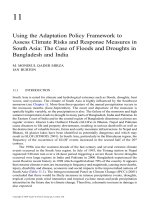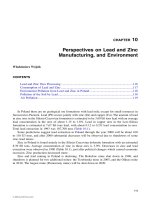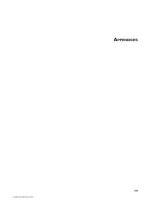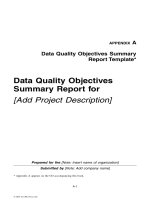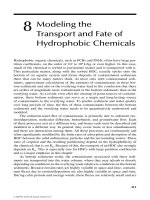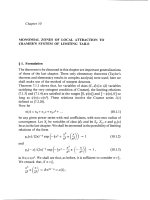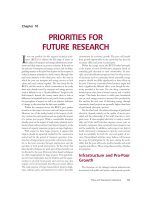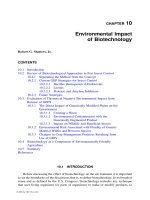ORGANIC SOILS and PEAT MATERIALS for SUSTAINABLE AGRICULTURE - CHAPTER 10 (end) ppsx
Bạn đang xem bản rút gọn của tài liệu. Xem và tải ngay bản đầy đủ của tài liệu tại đây (412.42 KB, 13 trang )
CHAPTER
10
Agricultural Production Systems for Organic
Soil Conservation
Piotr Ilnicki
CONTENTS
Abstract
I. Introduction
II. Agricultural Use of Organic Soils in Europe
III. Profile of Cultivated Organic Soils
IV. Water Balance
A. Peatland Drainage
B. Flooding and Runoff
V. Subsidence
A. Initial Subsidence
B. Long-Term Subsidence
VI. Best Management Practices for Organic Soil Conservation
VII. Conclusion
References
ABSTRACT
Largest areas of farmed organic soils in Europe are found in Russia (70,400
km
2
), Germany (12,000 km
2
), Belarus (9631 km
2
), Poland (7620 km
2
), and the
Ukraine (5000 km
2
). In comparison, cultivated organic soils in United States and
Canada cover 3080 km
2
altogether. In Europe, the agricultural use of organic soils
takes 14% of total peatland area. Climatic factors limiting agricultural production
on organic soils, a food production surplus and a serious environmental crisis led
to European Union Directive No. 2078/92 intended to exclude large areas of peat-
© 2003 by CRC Press LLC
lands from agricultural production. In most European countries, arable land use is
advised only for shallow (< 1.0 m) or very shallow (< 0.5 m) peat deposits, or sand
cover peat cultivation. Organic soil subsidence, a key factor in soil conservation, is
primarily related to groundwater level. Depending on climatic conditions, intensity
of drainage, peat type and land management, the annual loss of elevation is in the
range of 0.3–1.0 cm yr
–1
for grassland, and 1.0–5.0 cm yr
–1
for arable land. Grassland
is given priority in Europe due to shallower drainage, protection against frost, as
well as reduced peat mineralization, CO
2
and NO
x
emissions, and nitrate leaching.
I. INTRODUCTION
Peat is regarded as an important energy source in Finland, Ireland, Russia, and
Sweden. In central and northern Europe, peat is also excavated for producing hor-
ticultural substrates for greenhouses and mushroom-growing cellars. In northern
Europe, a large proportion of mires is covered by commercial forests. In Scotland,
Highland heather peatlands are used as hunting grounds.
Organic soils are cultivated in northern countries such as England, southern
Norway, Sweden and Finland, in the southern fringe of Karelia, and in central Russia
up to the Moscow region; there, raised bogs dominate in the North, and fens in the
South. Intensive agricultural use of peatlands is found in The Netherlands, Germany,
Poland, Belarus, and the Ukraine. The capability of organic soils for agricultural
production depends on climate, requirements for nature protection, mire geomor-
phology and vegetation, peat stratigraphy, stage of the moorsh forming process, the
air-water regime, and soil physico-chemical properties.
A large food production surplus and a serious environmental crisis led to a
European Union directive (Council Regulation No. 2078/92) to exclude peatlands
from agricultural production. As a result, large areas of peatlands were converted to
sylviculture and nature conservation considering high drainage costs, high nitrate
content in some vegetables, and cereals lodging. In Poland, national parks were
established on 66,000 ha in the Biebrza and Narew River Valleys. In Germany, a
national park was created in the lower Odra valley together with a nature conservation
area of 45,000 ha.
The aim of this chapter is to provide a European perspective for parsimonious use
of peatlands in agriculture, considering biophysical and socioeconomic limitations.
II. AGRICULTURAL USE OF ORGANIC SOILS IN EUROPE
Macroclimatic factors limiting agricultural production on organic soils are:
1. Too short a vegetation period
2. Too low a mean annual temperature
3. Too large a difference between mean temperatures in July and January
4. Too large temperature differences between day and night
© 2003 by CRC Press LLC
5. Frequent frost
6. Not enough accumulated degree-days during the vegetation period
The microclimate is also more severe in organic than in surrounding mineral
soils. Organic soils are developed in lower topographical positions characterized by
a higher temperature amplitude, higher frequency of frost, and higher relative air
humidity. Thermal capacity is higher, and thermal conductivity is lower, in organic
than in mineral soils. Thermic properties of the surface soil layer (0 to 0.2–0.3 m)
depends on the volume occupied by organic and mineral substances, water, and air.
Organic soils are cooler than mineral soils during the summer months and warmer
during the winter (Table 10.1).
Compared with mineral soils, the range of agricultural production on organic
soils is shifted to lower altitudes or latitudes. Land use data for organic soils are
still scattered and frequently not reliable (Lappalainen, 1996). Areas of organic soils
under agricultural use decreased in Europe due to economic reasons and to the need
for nature protection (Table 10.2). The largest areas are found in Russia (70,400
km
2
), Germany (12,000 km
2
), Belarus (9631 km
2
), Poland (7620 km
2
), and the
Ukraine (5000 km
2
). Cultivated organic soils in the United States and Canada cover
3080 km
2
altogether (Lucas, 1982). Agriculture occupies 14% of European peatlands,
but 98% in Hungary, 90% in Greece, 85% in The Netherlands and Germany, and
70% in Denmark, Poland, and Switzerland. Meadows and pastures are considered
to be the most effective conservation practice (see Table 10.3 for Poland). Arable
lands are found mainly in Germany, The Netherlands, and Belarus.
III. PROFILE OF CULTIVATED ORGANIC SOILS
In Europe, toward the East from the Elbe River, only fens are in agricultural
use. In countries with maritime climates, both fens and raised bogs are used for
agricultural production. In The Netherlands and Germany, reclamation methods were
Table 10.1 Mean Annual Soil and Air Temperatures in the Biebrza River Valley and
on Mineral Soils of Bialystok in the 1951–1965 Period
Location Substrate
Height/Depth
(cm)
Average Temperature °C
January July Annual
Mineral soils in Bialystok Air +200 –5.1 17.5 6.4
Soil –5
–10
–20
–50
–2.1
–1.9
–1.5
0.1
19.8
19.6
19.3
18.2
8.0
8.0
8.0
8.1
Organic soils in Biebrza Air +200 –4.9 16.5 6.0
Soil –5
–10
–20
–50
–1.8
–1.3
–0.1
2.4
17.5
17.1
15.9
13.3
7.2
7.1
7.0
7.2
Source: From Kossowska-Cezak, U., Olszewski, K., and Przybylska, G. 1991. Zeszyty
Problemowe Postepow Nauk Rolniczych, 372:119–160. With permission.
© 2003 by CRC Press LLC
developed with partial or total reconstruction of the soil profile such as sand cover
cultivation and deep ploughing.
The early Dutch fehn cultivation of raised bogs used in The Netherlands and
Germany completely transformed the organic soil profile. A profitable alternative to
peat burning in populated areas at the end of the 16th century, the Dutch fehn
cultivation lasted till the beginning of the 20th century. Fibric peat was removed
from mire surface, and the underneath sapric black peat was mined for fuel down
to the subsoil. The top fibric peat used as filling material was applied onto the subsoil
(40 cm thick). Sand and city wastes were added to make up an arable layer (10–14
cm thick) on top of the fibric peat, thus reconstituting an agricultural soil. At the
end of the 19th century, the German peatland cultivation methods transformed bog
and fen peat materials into productive soils with proper liming and fertilization;
however, ploughing and mixing of the soil profile was required to improve root
penetration due to low peat permeability (Figure 10.1).
A sand covering method was proposed in 1860 by Rimpau for the shallow fens
of East Germany. The sand was excavated from bottom of a dense ditch network
(15–20 m). Mechanized sand cover cultivation was later conducted in thick fens and
Table 10.2 Peatland Used for Agriculture in European Countries
No. Country
Total Area
(km
2
)
Peatland Area Used
for Agriculture
(km
2
) (%)
1 Belarus 23,967 9631 40
2 Czech Republic and Slovakia 314 ca 100 ca 30
3 Denmark 1420 ca 1000 ca 70
4 Estonia 10,091 ca 1300 13
5 France ca 1100 ca 660 ca 60
6 Finland 94,000 ca 2000 2
7 Germany 14,200 ca 12,000 85
8 Great Britain 17,549 720 4
9 Greece 986 ca 900 ca 90
10 Hungary 1000 975 98
11 Iceland 10,000 ca 1300 13
12 Ireland 11,757 896 8
13 Latvia 6691 ca 1000 15
14 Lithuania 4826 1900 39
15 Netherlands 2350 2000 85
16 Norway 23,700 1905 8
17 Poland 10,877 7620 70
18 Russia 568,000 70,400 12
19 Spain 383 23 6
20 Sweden 66,680 3000 5
21 Switzerland 224 ca 160 ca 70
22 Ukraine 10,081 ca 5000 ca 50
Total 880,196 124,490 14.1
Note: ca = approximately.
Source: From Lappalainen, E., Ed. 1996. Global Peat Resources. Int. Peat
Soc. Geological Survey of Jyskä, Finland, 359 pp. Changed and supple-
mented. With permission.
© 2003 by CRC Press LLC
bogs (up to 2.4 m thick) using the Rathjens Kuhlmaschine, a subsoil conveyor. The
Rathjens machine dug down to 3.5 m in the soil to bring 1 m
3
sand per m length to
the surface, and spreading sand to form a sand layer about 10 cm thick. The German
sand mix cultivation of raised bogs by deep ploughing resulted in alternate rows of
peat and sand at an angle of 135° and in sand covering the peat. The peat:sand ratio
was between 2:1 (coarse sand and fibric peat) and 1:2 (fine sand and sapric peat).
Organic matter content at the surface was 6 to 8%. These methods improved the
air–water regime, the microclimate, and soil carrying capacity in an area over
300,000 ha in The Netherlands and northwestern Germany (Emsland). In most
European countries, arable land use is advised only for shallow (<1.0 m) or very
shallow (<0.5 m) peat deposits, or sand cover cultivation. In Belarus, however, thick
organic soils are often used as arable land, and shallow soils as grassland.
A soil profiling technique called “land crowning” was developed in Sweden for
draining peatlands above the polar circle (Berglund, 1996). The shallow upper layer
is ploughed in the direction of the centre to form a narrow bed (to 10 m wide). After
a few years of soil modeling, the central part of the bed was elevated, and furrows
could drain excess water on both sides of the bed.
Physicochemical properties of soil surface materials (0–30 cm) depend on peat
type, pH and fertility, stage of the moorsh-forming process (MFP), and contamina-
tion. The MFP is slowest in soils under meadow and pasture, and for high water
table levels (i.e., < 60 cm deep) (Okruszko, 1993). In Poland, most favorable
conditions for agricultural production are obtained in fens with low to medium ash
content (< 20%), fibric to hemic peat materials, low to medium MFP degrees, and
slightly acid to neutral soil pH values (5.5–7.0 in 0.1 M CaCl
2
). In some shallow
organic soils, sediments containing significant amounts of sulphur or calcareous
gyttja hinder root penetration.
IV. WATER BALANCE
A. Peatland Drainage
Mires can be classified according to water supply (rain, flowing water, spring
water, groundwater), and groundwater fluctuations (Kulczynski, 1949; Moore and
Table 10.3 Use of Fens (10,126 km
2
) and Bogs
(751 km
2
) in Poland
Use
Fen Bog
(km
2
) (%) (km
2
) (%)
Forest 917 9.1 353 47.0
Grassland 7436 73.4 129 17.2
Arable land 55 0.5 — —
Undrained peatland 1290 12.7 215 28.6
Cutover peatland 428 4.2 54 7.2
Source: From Lipka, K. 1984. Studia Kom. Przest.
Zagosp. Kraju, 85:56–77. With permission.
© 2003 by CRC Press LLC
Figure 10.1 Root development in peatland profiles modified by cultivation methods. (From Göttlich, Kh., Ed. 1980. Mire and Peat Science (in German). E.
Schweizerbartsche Verlagsbuchhandlung. Stuttgart, Germany. With permission.)
0
20
40
80
100
120
140
180
200
160
60
German-raised
mire cultivation
Fen black
cultivation
Fen sand cover
cultivation
Dutch fehn
cultivation
German sand
mix cultivation
Deep ploughing
sand cover
cultivation
Raised mire Muds
Sand Drain
Sand mixed with raised
mire peat
Fen Peat
© 2003 by CRC Press LLC
Bellamy, 1974; Göttlich, 1980; Dembek and Oswit, 1996). After mire drainage, soil
phase distribution changes from around 5% solid volume and 95% pore volume (2%
as air and 93% as water), to about 10% solid volume and 90% pore volume. To
achieve 20% air and 70% water contents in organic soils for growing crops, 1840
m
3
water ha
–1
may be evacuated for a drain depth of 80 cm (Göttlich, 1980). Due
to lower permeability in organic compared with mineral soils in northwestern Ger-
many, infiltration water is less than 30 mm yr
–1
in raised bogs and 30–60 mm yr
–1
in fens, compared with 100–200 mm yr
–1
in sandy soils (Eggelsmann, 1973a).
Because drainage and compaction may also reduce peat hydraulic conductivity, water
partitioning between infiltration and runoff may further change.
Meadows and pastures require a water table drawdown to 0.4–0.8 m, while the
water level could be as deep as 1.0–1.2 m for arable crops. By lowering the ground-
water table 0.5–1.5 m below soil surface, soil water retained at suction less than pF
1.8–2.0 is evacuated through a network of ditches and canals. Ditch spacing depends
on peat thickness and permeability. Until the end of the 19th century, draining
consisted of narrow (0.1–0.2 m) and deep (0.8–1.0 m) slits cut through peat by hand.
Later, mole drains were recommended. Slits and mole drains were replaced by more
durable drains made of ceramic or plastic pipes. Drains could be wrapped with
filtration materials to prevent silting (Eggelsmann, 1973b). Pumping systems were
designed for small (up to 50 ha) or large (hundreds or thousands of ha) polder areas.
Because small pumping facilities required a shallower network of main ditches and
thus maintained more uniform water table levels across the area, they were more
favorable to organic soil conservation compared with large systems.
B. Flooding and Runoff
Peatland drainage affects to some degree the water balance of catchment areas by
increasing flood hazards. Compared with an undrained analog, a drained raised bog
at Königsmoor, Germany, showed lower groundwater level and similar runoff during
winter, but larger runoff at the end of the summer (Eggelsmann, 1990). In the raised
bog of Chiemseemoor in Bavaria, the undrained portion discharged water at a slower
rate than the drained analog (Schmeidl et al., 1970) (Table 10.4); runoff was higher
in the drained portion of the bog during high rainfall and smaller during droughts.
For a mean annual precipitation of 729 mm during the 1968–1979 period in a
drained raised bog at Ritschermoor in the Elbe River Valley, Germany, mean runoff
was 341 mm, about 100 mm higher than the annual climatic water balance of +238
mm, due to an underground water supply (Ilnicki and Burghardt, 1981). In the case
of a negative climatic water balance, annual runoff was about 250 mm, indicating
a plateauing of summer flow. In undrained raised bogs, surface runoff may dominate
because peat is saturated almost year round (Eggelsmann, 1990). During a dry spell,
water discharge may stop. Five to 10 years after drainage, water balance resembled
the original one (Eggelsmann, 1990). A high proportion of peatland areas in the
catchment could decrease their water runoff during May–February and increase their
maximum spring runoff (Ferda, 1973). Distribution of runoff values for the Biebrza
River draining about 100,000 ha of peatlands in northeastern Poland indicated a
© 2003 by CRC Press LLC
plateau during summer months. The plateau was higher the larger the catchment
area, more distinctly in dry than in wet years (Byczkowski and Kicinski, 1991).
V. SUBSIDENCE
A. Initial Subsidence
Subsidence of organic soils first results from loss of buoyancy upon drainage.
Successive soil drying and wetting cycles cause irreversible peat shrinkage and
swelling leading to fissures and a granular structure. Peat materials change into
Mursz (in Polish), vererdete-Torfböden (in German), Terre noire (in French), and
muck or earthy peat (in English). The term moorsh was proposed by Henryk
Okruszko (Okruszko, 1993) to describe the material derived from MFP.
According to Segeberg (1962), peat mineralization proceeds until ash content of
surface soils reaches 900 g kg
–1
, the target for sand cover cultivation. Subsidence is
slower in deeper peat layers. There are two phases of peatland subsidence after
drainage as follows:
1. Initial subsidence is caused by load and shrinkage of upper peat layers depending
on drainage depth (Segeberg, 1960).
2. Microbial oxidation consumes organic soils in the long run as influenced by soil
type, temperature, and groundwater level (Mundel, 1976).
Due to uneven moisture distribution, subsidence is not spatially uniform. Sub-
sidence is intensified by peat fires, wind and water erosion. Peatland subsidence rate
is higher the thicker the peat strata, the lower the peat bulk density, and the deeper
the free draining ditches.
Soil subsidence during the first phase (5 to 10 years after drainage) is frequently
calculated by one of the three following empirical equations obtained by measuring
subsidence and its main causal factors in drained peatlands:
Hallakorpi equation (Finland): (10.1)
Panadiadi-Ostromecki equation (Eastern Europe): (10.2)
Table 10.4 Change in Water Balance after Drainage of a Raised Bog at
Chiemseemoor, Germany, during the 1959–1968 Period
Land Use
Water Runoff (mm)
Groundwater
Level (cm)
PET
a
(mm yr
–1
)Year Winter Summer
Undrained with
Sphagnetum medii
808 368 440 17.6 655
Drained — meadow 843 401 442 32.8 604
a
Potential evapotranspiration.
Source: From Schmeidl, H., Schuch, M., and Wanke, R. 1970. Schriften für Kura-
torium Kulturbauwesen, 19:1–171. With permission.
Sa T=+(. . )0 080 0 066
STAd
gw
=
3
2
© 2003 by CRC Press LLC
Segeberg equation (Germany, The Netherlands): (10.3)
where S is subsidence (m); a, A, k are constants depending on peat density
(Table 10.5); T is peat thickness before drainage (m); the Panadiadi-Ostromecki d
gw
is the lowering of groundwater (here ditch depth) after drainage (m); the Segeberg
d is drainage depth after subsidence (m), computed by difference between ground-
water levels before and after drainage. Hallakorpi’s formula assumes a drainage
depth of 1.1 m. Equations 10.1 to 10.3 were elaborated from varied parameters in
recently drained peatlands, but could be used for a second drainage phase.
B. Long-Term Subsidence
The second stage is dominated by the biologically driven peat decay. The inten-
sity of the long-term subsidence depends on drainage intensity, climatic conditions,
land use and management, peat bulk density, and, to some extent, the botanical
composition influencing MFP.
Ilnicki (1977) found that power equations for organic soil subsidence for 30
years (S in cm) at the Ritschermoor mire depended on bulk density as follows:
Loose peat materials: S = 14.3t
0.442
(10.4)
Rather loose peat materials: S = 7.35t
0.478
(10.5)
Rather dense peat materials: S = 5.14t
0.485
(10.6)
Long-term studies conducted in the Notec Valley led to models describing the
subsidence of deep organic soils made of reed peat and used as meadows (Ilnicki,
1973). During the 1903–1969 period, subsidence rate was 0.33 cm per year with
shallow ditches (0.4–0.6 m) and 1.12 cm yr
–1
with deep ditches (1.0–1.2 m).
Table 10.5 Constants Related to Peat Bulk Density in Subsidence Models:
S as Subsidence (m), T as Peatland Thickness before Drainage (m),
d as Ditch Depth after Drainage (m), and d
n
is Drainage Depth after
Subsidence (m)
Hallakorpi Model
Panadiadi–Ostromecki
Model Segeberg Model
Bulk Density
Qualitative a
a
Bulk Density
(g cm
–3
)A
b
Solid Volume
(% v/v) k
c
Loose 2.85 0.079 0.49 <5.0 0.303
Rather loose 2.00 0.093 0.35 5.0–7.4 0.219
Rather dense 1.40 0.109 0.25 7.5–12.0 0.154
Dense 1.00 0.128 0.18 >12 0.113
a
S = a(0.080T + 0.066)
b
S =
c
S = k d
n
T
0.707
Source: From Ilnicki, Wiadomouci Mel., 1965, vii:57–61. With permission.
TAD
gw
2
3
S kdT=
0 707.
© 2003 by CRC Press LLC
Schothorst (1977) studied peatland pulsation in deep fens drained between the
9th and 14th centuries in The Netherlands, and now used as pastures. By comparing
bulk density of organic matter in layers above and below groundwater level, he
estimated that 15% of total subsidence of 2 m over the past 1000 years could be
ascribed to shrinkage of the upper layer, and 85% to oxidation of organic matter.
The rate of organic matter loss was 2 mm yr
–1
for high water table (0.2–0.5 m), up
to 6 mm yr
–1
with deeper drainage.
Stephens (1960) and Harris et al. (1961) showed that subsidence resulting from
decomposition of organic matter was related to groundwater level. Peat mineraliza-
tion in German fens was investigated by Mundel (1976). The greatest influence was
exerted by the water table level and soil temperature. Highest rate of organic matter
decomposition (490 g C m
–2
yr
–1
or 0.3 cm yr
–1
) was associated with a 90-cm
groundwater level. In Florida and California, subsidence rate under vegetable crop-
ping reached 7 cm yr
–1
for a 1.0 m-deep groundwater level (Stephens, 1960). In
Israel, agricultural use of peatland can lead to an oxidation rate up to 10 cm yr
–1
(Levin and Shoham, 1972). Subsidence rate of drained organic soils is typically
found in the range of 0.3–1.0 cm yr
–1
for grassland, and 1.0–5.0 cm yr
–1
for arable
land. A synthesis of subsidence data of the second phase (microbial decomposition)
is shown in Fig. 10.2 (Maslov et al., 1996). The values range from 1 to 7 cm yr.
–1
Figure 10.2 Subsidence through biological oxidation. (Adapted from Maslov, B.S., Kolganov,
A.V., and Kreshtapova, V.N. 1996. Peat Soils and Their Change under Amelioration
(in Russian). Rossel’khozizdat Ed., Moscow, 147 pp. With permission.)
Time elapsed since reclamation (yr)
10 20 30 40 50 60 100 140
2
4
6
8
10
12
Subsidence rate (cm yr
-1
)
Minimum rate curve
Average rate curve
Maximum rate curve
© 2003 by CRC Press LLC
Maximum values were obtained for peat with low ash content and bulk density of
0.08–0.10 g cm
–3
, warm climate, and arable farming.
VI. BEST MANAGEMENT PRACTICES FOR ORGANIC
SOIL CONSERVATION
Optimum use of organic soils must take into account several natural, social,
and economic considerations. Natural conditions are temperature, air–water regime,
plant communities, peat stratigraphy, soil properties, as well as valuable species
and ecosystems. National security, population density, demand for food, and agri-
cultural policy are the social conditions. The economy of peatland use includes
cost for fuel and infrastructure, competing uses, production efficiency, biodiversity
and economic policy.
Arable farming is expensive to establish on vast peatland areas requiring the
construction of infrastructures. Meadows and pastures need shallower drainage, are
more resistant to frost, and less subject to peat mineralization, emission of carbon
dioxide and nitric oxides, and nitrate leaching.
In Europe, the range of field, horticultural and nursery crops grown on organic
soils is usually limited to potatoes and spring crops. In North America, crop range
is much larger (Lucas, 1982). Vegetables grown in organic soils may accumulate
nitrates in their tissues. Advantages of growing vegetable crops in organic soils
include large water supply and low-energy requirement for tillage. In western
Europe, arable farming on organic soils is facilitated by sand cover, which
increases soil bearing capacity. The largest problem with field crop agroecosystems
is the accelerated mineralization of organic matter leading to fast decession of
organic soils.
Meadows and pastures occupy 80 to 85% of total peat farmland in Europe. They
do not require deep drainage, thus slowing down MFP and conserving soil. In the
long run, however, the meadow also leads to peat wastage. Grassland covers all
types of organic soils. In England, The Netherlands, and Germany, pasture imposes
a permanent pressure from cloven hooves of animals, limiting peat mineralization
even more than in meadows. In eastern Europe, meadows were established because
of a more severe climate on organic than on mineral soils, and of the impossibility
to pasture animals on remote organic soil areas. Compared with arable farming,
grassland increases biodiversity and supplies refuge to waterfowl and rare mammals.
In other words, when agricultural use of peatland is considered in Europe, grassland
is given priority.
VII. CONCLUSION
The capability or organic soils for agricultural production depends on many
natural and socioeconomic conditions. Nowadays, agriculture uses only 14% of
European peatlands. Depending on climatic conditions, intensity of draining, peat
© 2003 by CRC Press LLC
type and land management, the annual loss of elevation is in the range of 0.3–1.0
cm yr
–1
for grassland, and 1.0–5.0 cm yr
–1
for arable land. The wisest use of organic
soils in Europe is grassland or wetland restoration.
REFERENCES
Berglund, K., 1996. Peatland drainage for agricultural purposes in the north of Sweden.
Proc.10th Int. Peat Congr. 1:79.
Byczkowski, A. and Kicinski, T. 1991. The hydrology and hydrography of the Biebrza River
basin (in Polish). Zeszyty Problemowe Postepow Nauk Rolniczych, 372:75–118.
Council Regulation 2078/92. 1993. Agricultural production methods compatible with the
requirements of the protection of the environment and the maintenance of the coun-
tryside. Official J. European Commun., L 215/85.
Dembek, W. and Oswit, J. 1996. Hydrological feeding of Poland’s mires. Proc. 10th Int. Peat
Congr., 2:1–12.
Eggelsmann, R. 1973b. The thermal constant of different high-bogs and sandy soils. Proc.
4th Int. Peat Congr., 3:371–382.
Eggelsmann, R. 1973a. Drainage Instructions. Agriculture, Engineering, Landscape Manage-
ment (in German). Verlag Wasser und Boden, Axel Lindo, Hamburg, Germany.
Eggelsmann, R., 1990. Water regulation in mires (in German), in Moor- und Torfkunde.
Göttlich, Kh., Ed., E. Schweizerbartsche Verlagsbuchhandlung. Stuttgart, Germany,
321–349.
Ferda, J. 1973. Hydrological function of mires in mountainous areas (in German). Zeitschrift
für Kulturtechnik und Flurbereinigung, 14:178–189.
Göttlich, Kh., Ed. 1980. Mire and Peat Science (in German). E. Schweizerbartsche Verlags-
buchhandlung. Stuttgart, Germany.
Harris, C.J. et al. 1961. Water level control in organic soils, as related to subsidence rate,
crop yield and response to nitrogen. Soil Sci., 94:158–161.
Ilnicki, P. 1965. Peatland subsidence. (in Polish).Wiadomosci Mel. £ak.3.VII:57–61.
Ilnicki, P. 1973. Subsidence rate of reclaimed peatlands in the Notec River Valley (in Polish
with English summary). Zeszyty Problemowe Postepów Nauk Rolniczych, 146:33–61.
Ilnicki, P. 1977. Subsidence in repeatedly drained bog mires of northwestern German flatlands,
3. Report: Assessment (in German). Zeitschrift für Kulturtechnik und Flurbereini-
gung, 18:153–165.
Ilnicki, P. and Burghardt, W. 1981. Subsidence in repeatedly drained bog mires of northwestern
German flatlands, 6. Report: Influence of climatic water budget and flow on relief
formation, and on surface and drain subsidence (in German). Zeitschrift für Kultur-
technik und Flurbereinigung, 22:112–121.
Kossowska-Cezak, U., Olszewski, K., and Przybylska, G. 1991. Climate in the Biebrza Valley
(in Polish). Zeszyty Problemowe Postepow Nauk Rolniczych, 372:119–160.
Kulczynski, S. 1949. Peat bogs of Polesie. Mémoires de l’Académie Polonaise des Sciences
et des Lettres, Série B:1–356.
Lappalainen, E., Ed. 1996. Global Peat Resources. Int. Peat Soc. Geological Survey of Jyskä,
Finland, 359 pp.
Levin, I. and Shoham, D. 1972. Nitrate formation in peat soils of the reclaimed Hula Swamp
in Israel. Proc. 4th Int. Peat Congr., III:47–57.
Lipka, K. 1984. Economic opinion about peat deposits in Poland (in Polish). Studia Kom.
Przest. Zagosp. Kraju, 85:56–77.
© 2003 by CRC Press LLC
Lucas, R.E. 1982. Organic soils (histosols). Formation, distribution, physical and chemical
properties and management for crop production. Research Report 435, Michigan
State University, East Lansing, MI, 77 pp.
Maslov, B.S., Kolganov, A.V., and Kreshtapova, V.N. 1996. Peat Soils and Their Change
under Amelioration (in English). Rossel’khozizdat Ed., Moscow, 147 pp.
Moore, P.D. and Bellamy, D.J. 1974. Peatlands. Elek. Sci., London.
Mundel, G., 1976. Mineralization of fen peat (in German). Archiv für Acker Pflanzenbau und
Bodenkunde, 20:669–679.
Okruszko, H. 1993. Transformation of fen-peat soil under the impact of draining. Pol. Akad.
Nauk, 406:3–75.
Schmeidl, H., Schuch, M., and Wanke, R. 1970. Water content and climate of cultivated and
pristine bog mires in the Alps (in German). Schriften für Kuratorium Kulturbauwesen,
19:1–171.
Schothorst, C.J. 1977. Subsidence of low moor peat soils in the western Netherlands. Geo-
derma, 17:265–191.
Segeberg, H. 1960. Peatland subsidence after drainage and assessment with empirical equa-
tions (in German). Zeitschrift für Kulturtechnik und Flurbereinigung, 1:144–161.
Segeberg, H. 1962. Assessment of subsidence by peat shrinkage (in German). Zeitschrift für
Kulturtechnik und Flurbereinigung, 3:356–367.
Stephens, J.C. 1960. Subsidence of organic soils in the Florida Everglades. Soil Sci. Soc. Am.
Proc., 24:77–80.
© 2003 by CRC Press LLC
